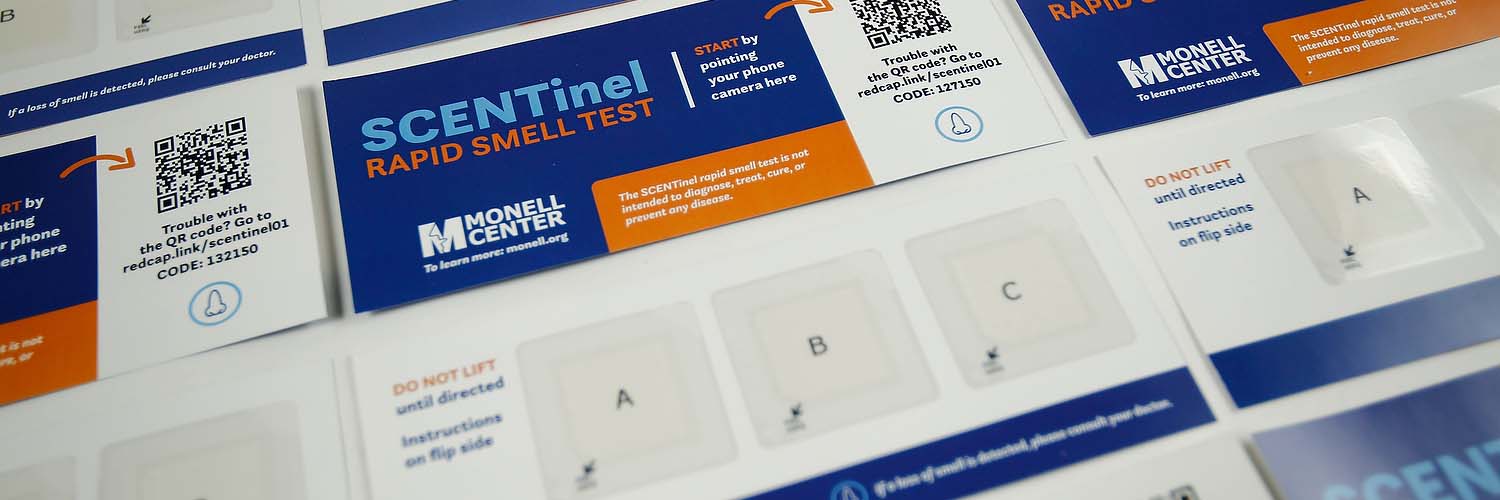For Immediate Release
Initially developed for population surveillance of smell loss associated with COVID-19, SCENTinel 1.1 is the second iteration of Monell’s rapid smell test. Study participants each received a SCENTinel 1.1 test card, which contains three Lift’nSmell patches of which only one has an odor. The test can then be self-administered, and it measures an individual’s ability to detect an odor, estimate the odor’s intensity, and state its identity. Additionally, SCENTinel 1.1 includes a measure of pleasantness, a key to the test’s ability to identify parosmia.
Participants were categorized according to their self-reported olfactory function: 66 were normosmics (had a normal sense of smell), 135 had only a quantitative olfactory disorder (anosmia or hyposmia), and 86 had only a qualitative olfactory disorder (parosmia or phantosmia). “Quantitative smell disorders are characterized by a decrease in the intensity of the odors that an individual can detect, whereas qualitative disorders are characterized by incorrect judgments of the identity of the odor or general reduction in odor pleasantness,” said senior author Valentina Parma, PhD, assistant director and assistant member at Monell.
SCENTinel 1.1 successfully and accurately discriminated between the three groups of participants. SCENTinel’s odor intensity measure was the one that best discriminated between participants with quantitative and qualitative disorders. Namely, participants with quantitative olfactory dysfunction rated odor intensities at lower rates compared to their counterparts with qualitative olfactory dysfunction.
Additionally, both the odor intensity and identification scores discriminated between normosmics and participants with quantitative smell disorders. And finally, the odor detection, identification, and pleasantness measures all discriminated between normosmics and participants with qualitative olfactory disorders.
“With 278 total participants, SCENTinel 1.1 is the first olfactory test that successfully detects parosmia, a qualitative disorder, to be used in such a large group of research participants,” said first author Stephanie Hunter, PhD, a postdoctoral fellow from the lab of Pamela Dalton, PhD.
The Monell Center’s SCENTinel is a promising tool, yet it just scratches the surface, say the authors, by identifying areas of smell dysfunction that should prompt further medical analysis. With SCENTinel in doctors’ hands, “we will no longer miss out on the opportunity to detect insidious disorders that are associated with the loss of smell,” added Hunter.
Currently, the research team is actively recruiting for their study to validate SCENTinel against gold standard smell tests to confirm its potential as a rapid screening tool for olfactory dysfunction. “Although validation is imperative, it may not be sufficient to allow for smell testing to be widely used,” said Parma. “Olfactory checkups are not yet streamlined into healthcare systems and procedures, but SCENTinel is a tool that lays the groundwork for smell testing to be incorporated into routine medical care and makes universal smell testing a real possibility.”
###
The Monell Chemical Senses Center is an independent nonprofit basic research institute based in Philadelphia, Pennsylvania. Founded in 1968, Monell‘s mission is to improve health and well-being by advancing the scientific understanding of taste, smell, and related senses, where our discoveries lead to improving nutritional health, diagnosing and treating disease, addressing smell and taste loss, and digitizing chemosensory data.


